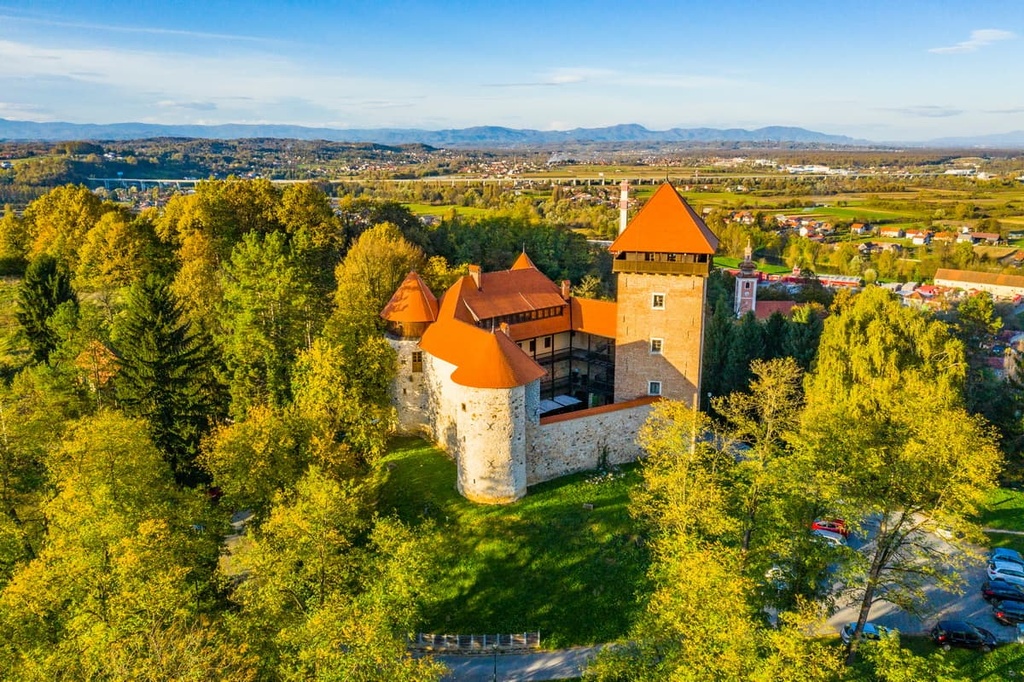Get PeakVisor App
Sign In
Search by GPS coordinates
- Latitude
- ° ' ''
- Longitude
- ° ' ''
- Units of Length

Yes
Cancel
Share ×

Scan the QR code and open PeakVisor on your phone
❤ Wishlist ×
Choose
Delete
If you love waterfalls and wild nature, Plitvice Lakes National Park is the perfect place for you. Plitvice Lakes National Park is a protected area located in central Croatia near the country’s border with Bosnia and Herzegovina. Here, one can enjoy excellent hikes and breathtaking vistas. There are 96 named mountains in Plitvice Lakes National Park. The highest and most prominent mountain in the park is Seliški Vrh (1,279 m/4,169 ft).
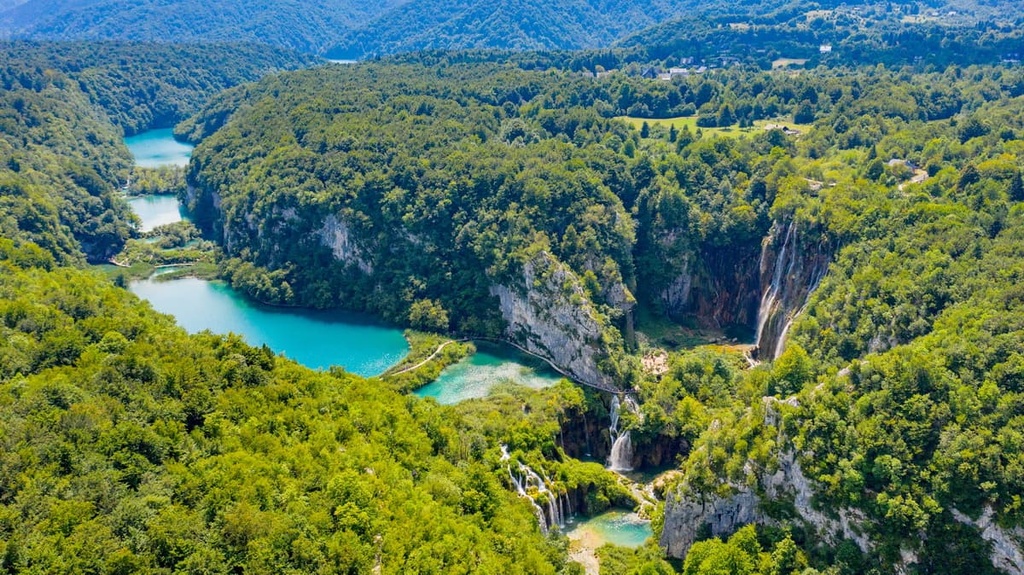
Plitvice Lakes National Park lies in the central part of the Dalmatia region of Croatia. In other words, the park is located in the hinterland of the Adriatic Sea. It is situated in the western part of the Balkan Peninsula and the mountains surrounding it are part of the Dinaric Alps.
The mountain located on the park's northern border is called Mala Kapela. Meanwhile, the Lička Plješivica mountain massif borders the park to the west. The park is also located within two counties, Lika-Senj County, and Karlovac County.
Plitvice Lakes National Park is one of Croatia's most popular tourist destinations. It is a national park with numerous lakes and waterfalls that are fed by the Crna (‘Black’) and Bijela (‘White’) rivers. It is both the oldest national park in Croatia and one of the oldest national parks in Europe.
The park was established in 1949, but it was not until 1979 that it became a protected area under the UNESCO Convention. Soon afterward, it was designated as a UNESCO World Heritage Site. Nowadays, Plitvice Lakes National Park receives more than 1 million visitors each year.
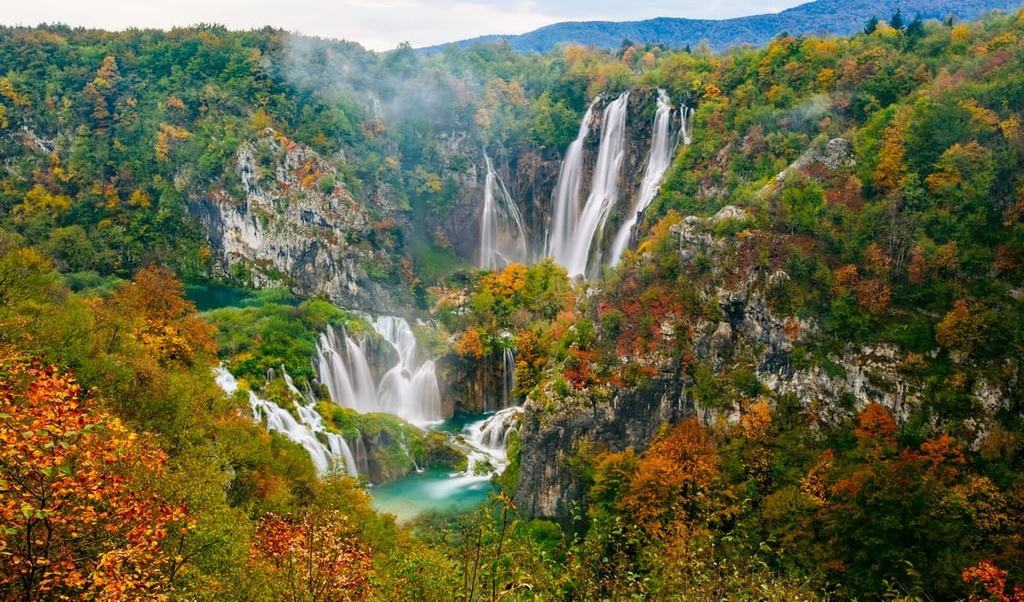
The park borders Bosnia and Herzegovina to the east, the Plješivica massif to the west, and the Mala Kapela massif to the north. It encompasses a total area of around 300 sq. km (186 sq. mi).
Most visitors to the park come to see the waterfalls that are carved out of tufa rock. Tufa is a type of calcium carbonate rock that forms via the precipitation of water, generally around mineral springs. The biggest waterfall in Plitvice Lakes is around 78 m (255 ft) tall. The width of the fall depends on the inflow of water from the lakes.
At Plitvice Lakes National Park, waves of water eroded a large area of tufa rock close to the edge of a cliff, creating an amphitheater-like space. The powerful sound of the falls is truly a wonder to behold, which is why the park is one of the most frequented places to visit in Croatia.
Interestingly, despite its name, only one percent of the park is covered by lakes. There are many different lakes in the park that cascade into each other, some of which are small and unnamed. The biggest lake in the park is Kozjak Lake. The lake's end is the impressive waterfalls of Sastavci, which boast a spring below the waterfall's base.
Plitvice Lakes is famous for its calcite rocks, including its large tufa outcroppings. The park is also home to large areas of limestone and other karstic features that are typical of the region.
Many of the lakes in the region formed as a result of tufa barriers. These tufa barriers might seem like little puddles, but they're actually between 6,000 and 7,000 years old.
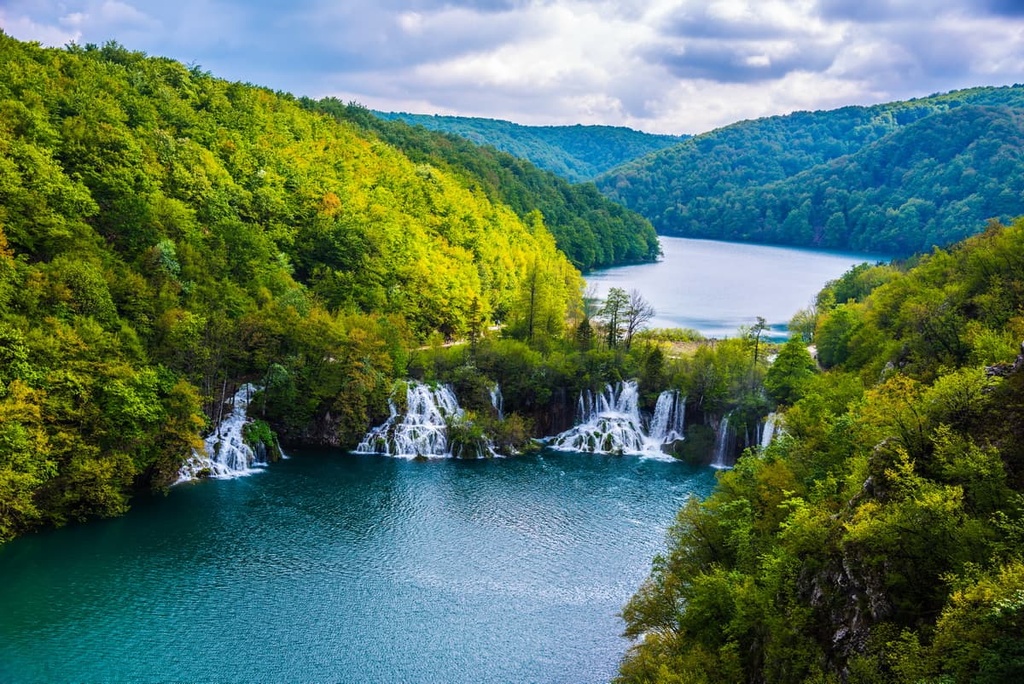
Remember, there is a difference between tufa and travertine. Travertine is a porous form of limestone that's typically formed from hot water. Tufa, on the other hand, is made from cooler water.
Travertine is the very soul of Plitvice Lakes, and thus it needs extra protection. Like tufa, travertine is a type of sedimentary rock that forms when carbonate sediments are precipitated around mineral springs (generally hot springs).
Changes in the water's chemical composition, draining, and physical forces can have a negative effect on travertine formation. Wooden bridges and paths over the top of the water make it possible to look at travertine outcroppings without damaging them. In fact, stepping outside of the pathways is forbidden in the park in order to protect these sensitive landscapes.
Meanwhile, the tufa sediments in the park can mostly be found in sinkholes or depressed areas between the surrounding mountains. As such, examining the underground of Plitvice Lakes can usually be divided into two zones. From an aerial perspective, you can see that the Upper and Lower Plitvice Lakes are very different.
The upper lakes in the southern part of the park predominantly consist of dolomite rock, which is slightly harder than limestone. Other parts of the park are dominated by a type of limestone that dates back to the Mesozoic. Indeed, just like the surrounding Dinaric Alps, this national park consists mainly of limestone and dolomite rock.
The national park also features a sizable area of karst topography that boasts a number of lakes, caves, and rock formations. The karst landscape is a result of water eroding away at soluble rocks like limestone. This erosion leaves behind a labyrinth of caves, sinkholes, and underground rivers, like what we can see under Plitvice Lakes National Park to this day.
The lakes in Plitvice Lakes National Park are interconnected. They are part of the same water system that flows through this karst landscape and that originates from the Mala Kapela and Velika Kapela mountains. The lakes gradually descend towards the Korana River Valley through natural karstic phenomena such as cascades, small dams, and waterfalls.
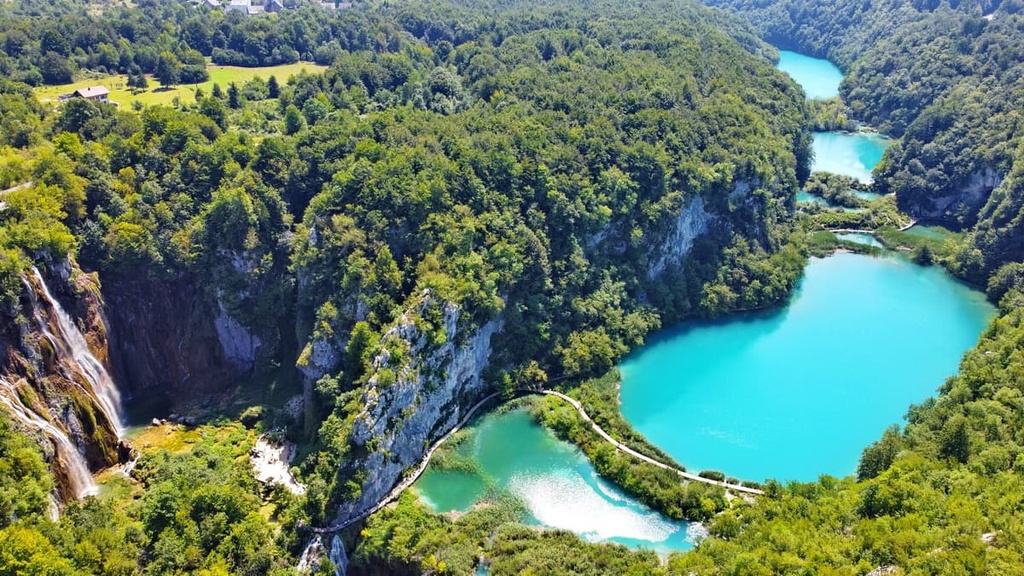
The park is not known for its mountainous terrain, but there are still some mountains to explore in the region. Some of the highest peaks in Plitvice Lakes National Park include:
Plitvice Lakes National Park is one of Croatia's most popular national parks, and it receives more than 1 million visitors per year. Despite its popularity among humans, Plitvice Lakes National Park is home to a number of flourishing ecosystems that support a range of plants and animals.
The park has six different types of habitats:
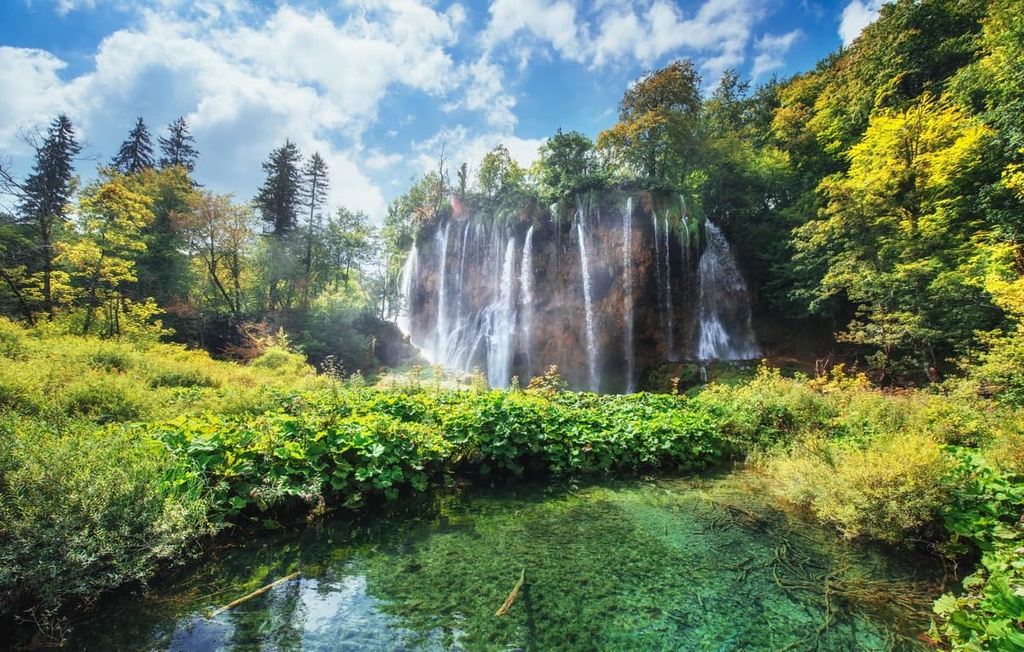
Plitvice Lakes National Park is full of forests, most of which are dominated by beech and spruce trees. Although much of the terrain features plants that are typical of the Mediterranean, some areas are more Alpine in nature. As a result, the park is home to a great diversity of flora.
The plants that you’ll find in the park and within the Dinaric Alps as a whole can vary depending on an area’s specific microclimate, soil type, and elevations. So far, 1,400 different types of plants have been found in the national park. This adds up to about 30 percent of Croatia's total flora. Of those, 75 of these species are endemic to the country.
This assortment of flora is due to the specific geographic location of the park. Plitvice Lakes National Park is located about 55 km (34 mi) away from the sea, which gives it a more Mediterranean feel. However, the park is also situated on the slopes of Mala Kapela and Lička Plješevica, so it has a more varied climate due to the higher elevation of the region as a whole.
Plitvice Lakes National Park is home to a number of endemic plant species. These include Dalmatian scilla (Chouardia litardierei), Lacy hellebore (Helleborus multifidus), and Croatian carnation (Dianthus croaticus).
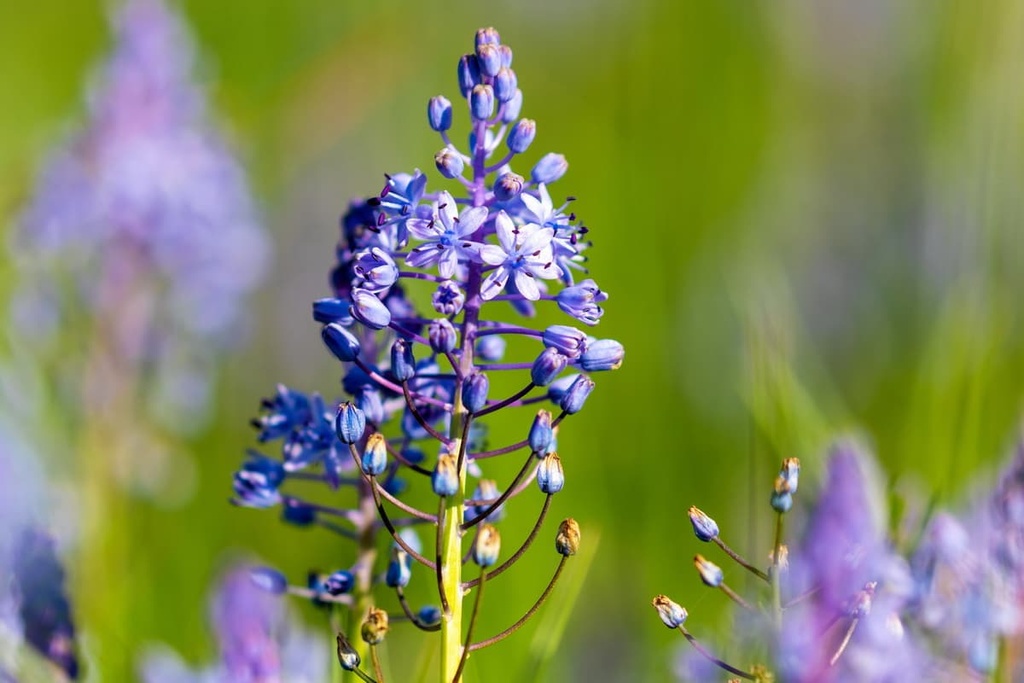
Plitvice Lakes National Park is home to a huge number of animal species. In fact, the wider area of the national park is one of the last areas in Europe where you can find great numbers of bears and wolves, not to mention other animals.
There are at least 50 species of mammals that live in Plitvice Lakes National Park. Regionally rare fauna like the European brown bear, gray wolf, eagle, owl, Eurasian lynx, roe deer, and wild boar all live within the park’s boundaries.
Plitvice Lakes ranks third among the Croatian national parks when it comes to the total number of bird species that can be found within its borders. Some 157 species live in the park and at least 70 bird species are known to nest in the area.
When it comes to fish species, the brown trout is one of the most notable residents of the park’s waterways. River trout (Salmo trutta fario) also live in the Upper Lakes and Lake Kozjak regions of the park.
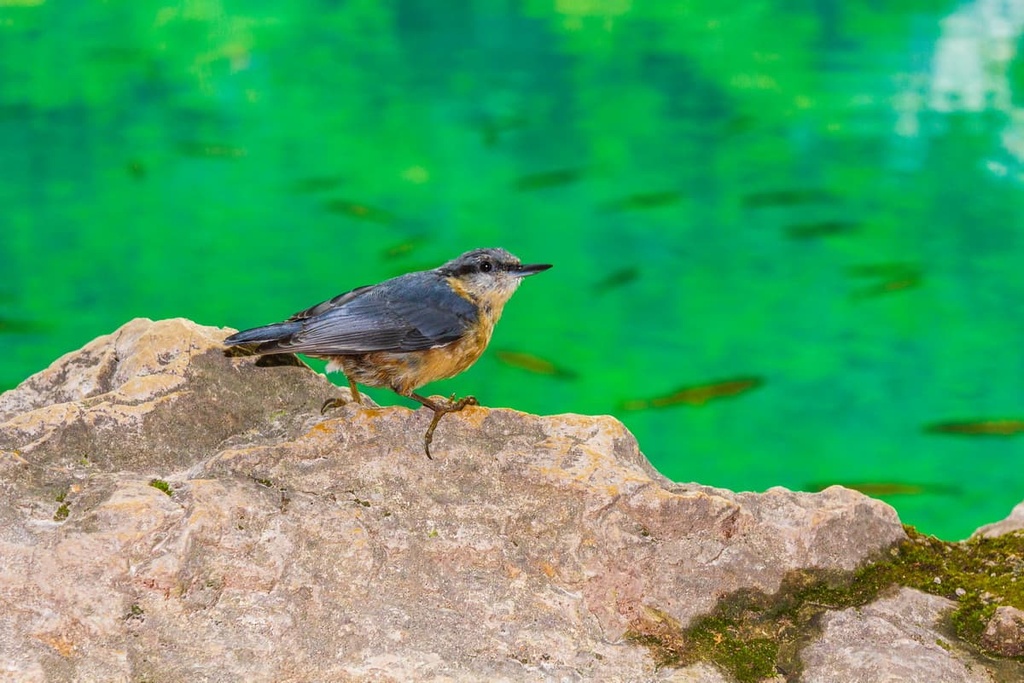
So far, researchers have also identified 321 different kinds of butterflies in the park, but they estimate that up to 40 percent of the region’s butterfly population has yet to be documented. Furthermore, there are at least 12 amphibian and reptile species that live within the park’s boundaries.
The first settlers in the area of what we know today as Plitvice Lakes National Park were various tribes during the Neolithic or Metal Age. Soon, the Illyrian tribes took over the Dalmatian Coast and hinterland, including what is now Plitvice.
Illyrians were an ancient people who lived in the Balkans and the eastern Mediterranean region. The Illyrians were a tribal society with a warrior culture and they primarily lived in small kingdoms. They were mostly known for their military strength, which allowed them to conquer many other empires. Of the many Illyrian people, the Iapodes tribe was the main group to live in what is now Plitvice Lakes National Park.
The Romans conquered Illyria in 228 BCE. But the Illyrians managed to preserve much of their culture, language, and religion during this time. Throughout this period, the bulk of the Illyrians lived in a Roman province called Illyria, which the Romans established to govern the locals and bring quality infrastructure to the region.
At the time of the Roman Empire, the area now known as Croatia was composed of two provinces, Pannonia and Dalmatia. After the Western Roman Empire fell to Ostrogoths in the fifth century, this area was left without a strong centralized government.
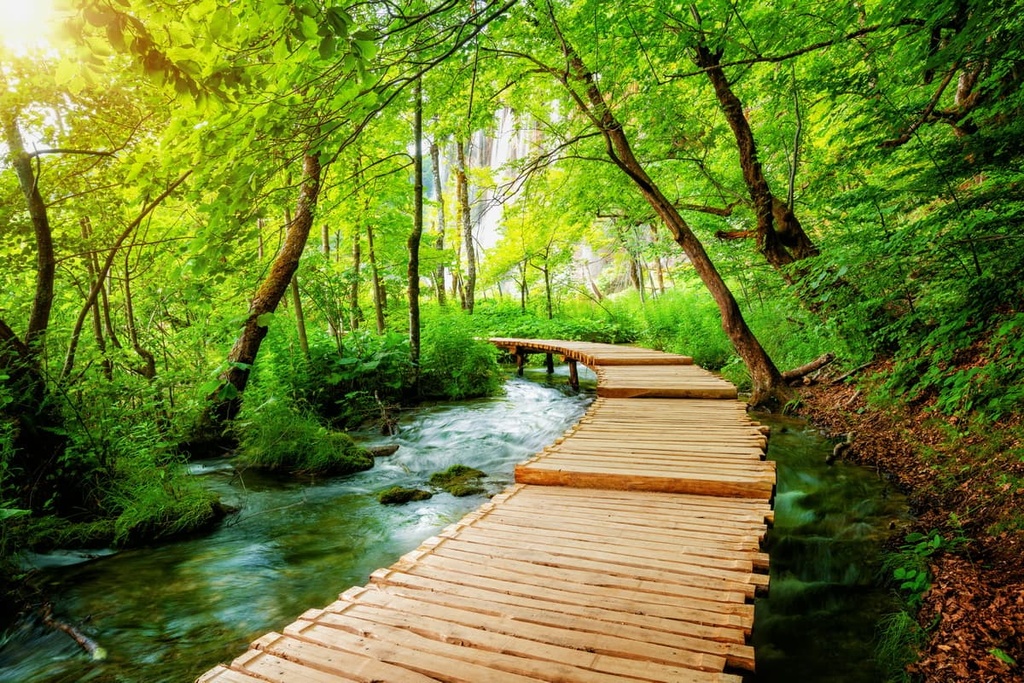
Throughout the sixth and seventh centuries, Croatian tribes started to settle throughout what is now the country of Croatia. As a whole, the people of the region converted to Christianity around 800 CE, and, soon afterward, they established their own independent state. The first prominent ruler of what is now Croatia was Branimir, who was the duke of Dalmatia from 872 to 879.
The state of Croatia, together with the area of today’s Plitvice Lakes National Park, first appeared in the seventh century when it was just a duchy. This duchy eventually grew, and in 925, it became the Kingdom of Croatia.
The Kingdom of Croatia existed as a sovereign country in Central Europe for centuries. Croatia's independence from Hungary and its position as a regional power that fought successfully against the Ottoman invasion contributed to its stability and prosperity.
Of course, the Balkans were not ignored by the Ottoman regime. The Ottoman conquest of much of the Balkans, including parts of what is now Bosnia and Herzegovina and Serbia, caused many Catholics to flee the area and re-settle in Croatia.
Soon enough, however, even Croatia fell under Ottoman rule. After the Ottomans lost control over the area, the Habsburgs gained power in Croatia, though Habsburg influence in the region ended with the First World War.
The Kingdom of Serbs, Croats, and Slovenes was created in 1918 after the collapse of the Austro-Hungarian Empire. This new kingdom consisted of land that is now part of Bosnia and Herzegovina, Croatia, and Slovenia.
The first version of the kingdom lasted for 31 years until 1941 when the Axis powers invaded Yugoslavia. This regime was known for its harsh rule and numerous atrocities, so the resistance movement under Josip Broz Tito fought back and liberated Croatia at the end of the Second World War.
As the war ended, the local countries rallied to create a state called the Socialist Republic of Yugoslavia. This communist state included modern Slovenia, Croatia, Bosnia and Herzegovina, Serbia, Montenegro, Macedonia, Vojvodina, and Kosovo.
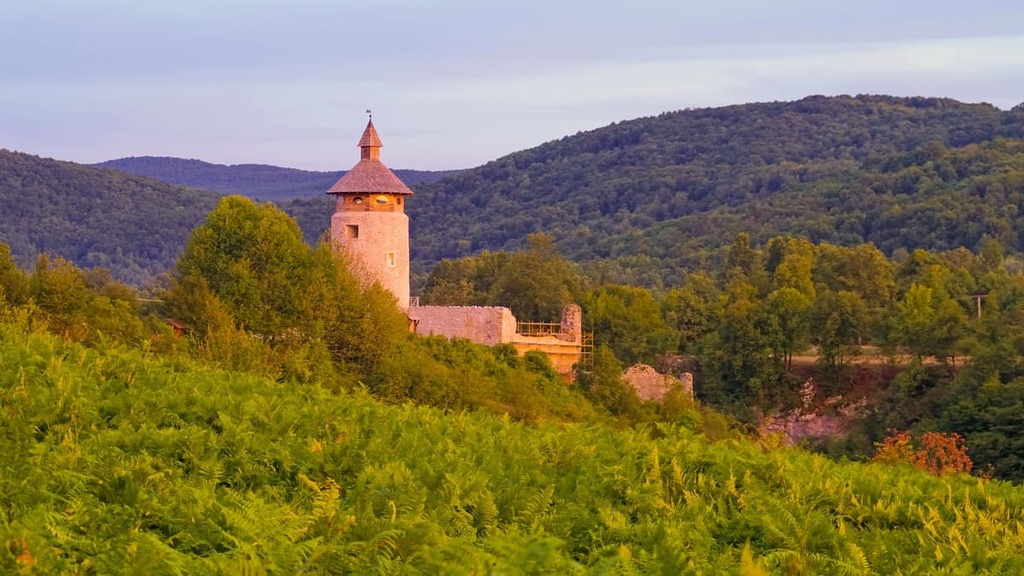
While these countries still had to live with some restrictions on their relationship with the West, they benefited from increased trade and tourism. Of course, Croatia fought what they call the Homeland War with Serbia, Slovenia, and Bosnia and Herzegovina after the fall of Yugoslavia.
The modern state of Croatia started to take shape after this war, which lasted from 1991 to 1995. Croatia formally declared its independence in 1991 and it joined the European Union in 2013.
Plitvice Lakes National Park is the oldest national park in Croatia. It was established in 1949, and it is one of the most popular tourist destinations in Croatia. The park is a UNESCO World Heritage Site and also a protected landscape area. The first record of people enjoying Plitvice Lakes as tourists dates back to 1777.
The first guesthouse in the area, Turistička kuća (which literally translates to ‘Tourism House’) was located on the plateau at Velika Poljana. This guesthouse was constructed in 1862 and a paved road soon followed. This road passed through Plitvički Ljeskovac via Mirić Štropina to Prijeboj and then went on, via Jezerce, to Velika Poljana (near Kozjak).
The first real hotel constructed at Plitvice Lakes was called Hotel Plitvice, and it was constructed between 1894 and 1896. It used to stand at the location of Velika Poljana until a fire burned it down. A new hotel was built at Plitvice between 1954 and 1958, and it was designed by architect Marijan Haberle.
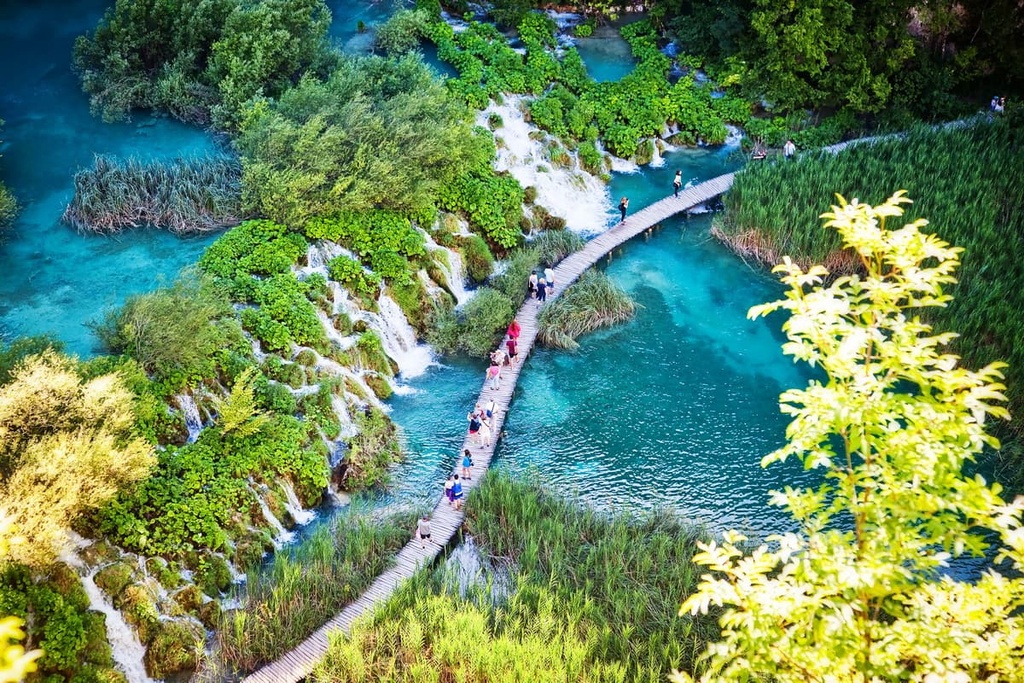
After World War II, the Plitvice Lakes area saw some new development, so in 1949 it was proclaimed as a national park. The National Park Administration was established in 1950, and it merged with Plitvice hospitality company in 1970. Construction and conservation groups have always been at odds in the area around Plitvice Lakes, but conservation experts have always held that the area should be pristine and untouched.
When visiting Plitvice Lakes National Park, you can enjoy any one of a number of activities, such as boating, cycling, rowing, and skiing. However, if you’re looking for a scenic way to pass the time during the summer months, hiking is your best bet.
Here are some of the best hikes in Plitvice Lakes National Park to consider during your next trip to the region.

The forests that cover Plitvice Lakes National Park are an ecological treasure that’s well worth exploring. There are a number of informative trails in Čurkova Bay that let you experience the unique forest systems native to the Plitvice Lakes area firsthand.
One of the best trails in the region is 21 km (13 mi) long, so it’s a great full-day outing for most hikers. This trail begins at Labudovac where it branches off from the Plitvica Trail. It then leads over Čorkova Uvala Village to Preka Kosa before reconnecting with the Plitvice Trail to take you back to Labudovac.
The Plitvica Trail leads you through large forests and mountain meadows that are perfect for the more adventurous among us.
This 9 km (5.5 mi) long trail takes you through forests and meadows as well as to scenic lakes. Near the trailhead, the Plitvica Trail separates from the Čorkova Uvala (Čurkova Bay Trail) and continues further downstream along the Plitvica Stream to Kozjačka Draga.
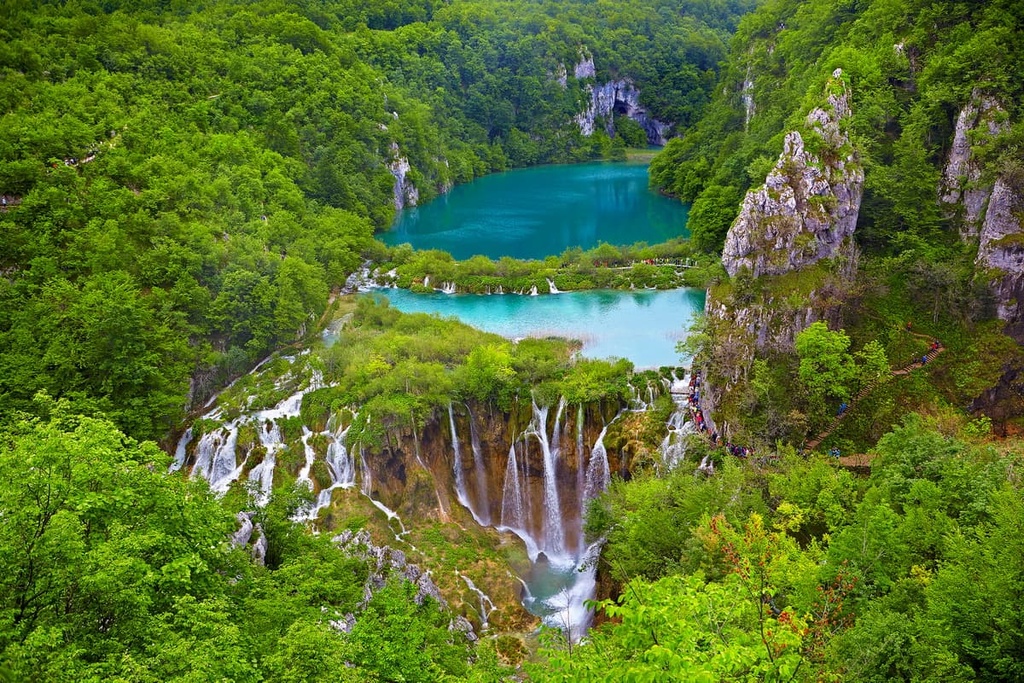
In 1884, local residents built a stone-paved trail to the top of Tupi Medveđak. A proper hiking trail was built in 1900 from the hotel to Oštri Medveđak, so there are plenty of ways to venture to the three main peaks in this part of the national park.
On the main Medveđak Trails, you’ll get to climb Oštri Medveđak (889 m/2,916 ft), Tupi Medveđak (868 m/ 2,847 ft) and Turčić (801 m/2,627 ft). One of the trails that leads to this ridge takes about 2 hours to complete while the other is a bit shorter and takes about 1.5 hours to hike.
One can reach Plitvice Lake National Park through Zagreb, Zadar, and Otočac. There are two entrances to the park, both of which are accessible by bus and car.
Here are some of the best cities located near the national park to visit during your next trip to the region.
The town of Karlovac is located in central Croatia. It lies on the river Kupa to the southwest of Zagreb. The Austrians founded the town in 1579, and it soon became the center of the government’s military operations against the Ottomans.
Nowadays, Karlovac is known for its baroque-style Catholic churches and old city walls. It has a population of about 55,000 inhabitants, and one can reach it by rail and road.

Zagreb is the capital and the largest city in Croatia. It is located in the northwestern part of the country along the Sava River and at the southern slopes of the Medvednica massif.
The city lies at an elevation of approximately 122 m (400 ft) above sea level. The Zagreb metropolitan area has a population of 1 million inhabitants.
Zagreb is Croatia's most populous urban area. As a result, in the city, you can enjoy numerous museums, art galleries, theaters, concerts, and festivals. One can reach Zagreb by air, rail, and road.
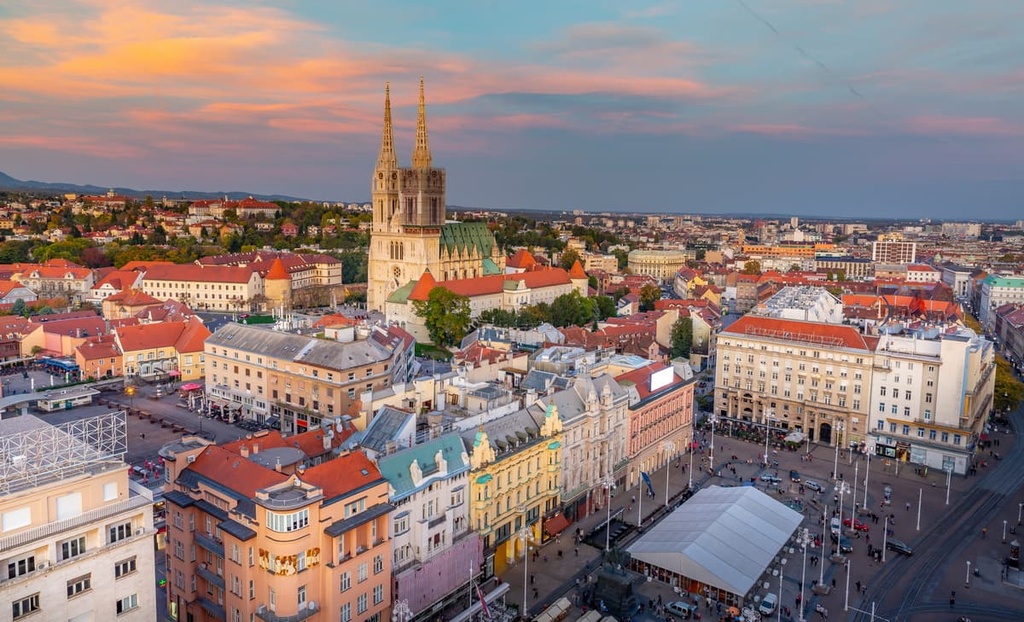
The city of Zadar is located on Croatia’s Adriatic Sea coast. It features some of the region’s most popular beaches and it has some unique attractions like the Sea Organ (Morske orgulje). Zadar is home to approximately 75,000 people, and it has been inhabited since the Stone Age.
Today, it is a popular tourist destination for anyone looking to spend some time by the sea. Zadar is home to a diversity of different accommodation options, from luxury hotels to campsites. You can reach the city by air, rail, road, or water.

Explore Plitvice Lakes National Park with the PeakVisor 3D Map and identify its summits.

